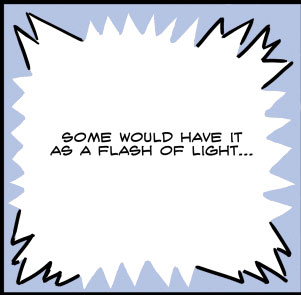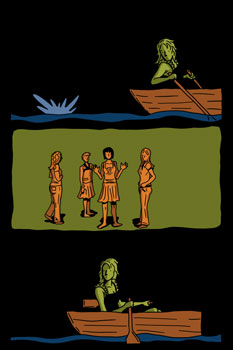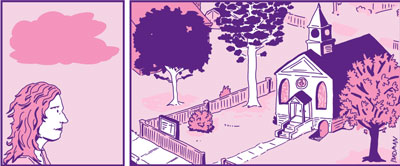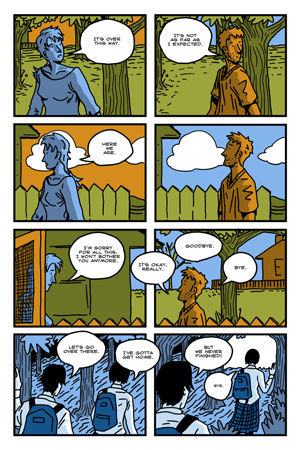Interviews
Things Change: Derik Badman Discusses The Metamorphoses Comic
By Beth Davies-Stofka
November 19, 2008 - 14:55
Comics critic and web comics artist Derik Badman has been working on his epic
Things Change: The Metamorphoses Comic for over two years, after finishing the run on his first web comic,
Maroon. Badman's semiweekly comic is guided by the ancient epic
Metamorphoses, by Roman poet Ovid. He sat down with
The Bin to share some insights into his ideas and his creative process.
Go here to read
The Bin's review of his ongoing, and mesmerizing epic.
CBB: How long have you been doing a web comic?
BADMAN: I started my web comic
Maroon in August of 2005 after a long hiatus from making comics. I'm not sure what made me start drawing comics again at that point.
From 1995 through 1999 (while I was in art school) I had created thirty-some issues of a photocopied minicomic called
The Partial Truth. I took a few years detour into writing (prose and some poetry) as my interest in literature (particularly experimental literature) overtook my interest in comics. I kept reading comics throughout that time, following all the indie books of the time. Eventually I started writing about them on my blog, which I started in 2004 to write about literary constraint and the
Oulipo.
Before starting
Maroon I discovered the Wacom tablet and went to work. I started
Maroon with almost no preparation and a simple yet constraining concept: that prototypical guy shipwrecked on a desert island. I had been reading a lot of old newspaper strips and decided to work on the model of a Sunday weekly strip. I already had my website, so I just added an extra section for web comics. Maroon was a lot of fun, but after a year I decided to end it (there’s only so much you can do with that concept).
Things Change started up in August of 2007 and it recently passed the two year mark.
That’s a longwinded answer to a question that only really requires a number!
CBB: Why web comics? You have an interest in experimenting with the formal aspects of comics – do web comics give you a unique means of experimentation?
BADMAN: The kind of experimentation I do doesn’t necessarily require web publication. I’m not using animation or infinite canvas (though I did of
Maroon that way) or unusually sized pages or anything that couldn’t be done on paper.
But I certainly wouldn’t be doing what I do if I weren’t creating the whole comic electronically. I draw straight into my computer with my Wacom tablet, no ink, no paper, which for me is a great blessing as I tend to be on the… particular side of using materials and making messes with them. By going completely electronic I’ve been able to experiment with color like I never had before. Most importantly, the web publication of my work gives me a cheap and easy way to make my work visible for readers (the very few that I have). Photocopied mini-comics have their charm, but getting them out there is a lot harder (more work, which I’d rather spend on the creation itself).
CBB: Can you say a bit about what you look for in a web comic? What would make you read any given web comic more than once?
BADMAN: I look for the same thing in a web comic that I would look for in any comic. I don’t really see “web comics” as something distinct from “comics”. In almost all cases the only difference between a “comic” and a “web comic” is the form of publication and dissemination. We see this more and more with the publication of books from web comics.
That said, what do I look for in a web comic? That’s a tough question. I’d start with originality (or at least a skillful form of copying), intelligence, an interesting style (interesting could be anything that strikes my fancy), and aesthetics that appeal to me. I enjoy comics with longer/larger narratives (
Finder,
BodyWorld,
Sin Titulo), but it’s not just plot that keeps my attention. I read almost no humor/gag strips (
xkcd and
Hutch Owen excepted). If the comic is fantasy or manga style it has to be really good (those seem to be the most prolifically bad genres/styles online). No gamer comics. Science fiction if it’s smart (again, Finder, BodyWorld). Autobiography/diary comics in rare cases (Trondheim’s
Les Petits Riens is my only one right now).
I love comics that really show a skill with the form of comics (more than just story or art) and a willingness to explore the form. I don't look for all these things at once. I'll overlook some factors if others are particularly good. You can see my current reading list on my comics'
home page. I’m not sure what the connecting feature is. Sometimes I realize my reading of a comic is more habit than enjoyment, and I end up cutting it from the list (there’s only so much time and I have plenty of print comics and books to read, let alone blogs about comics and libraries and other areas of interest).
CBB: Tell us a bit about Things Change. Why Ovid?
BADMAN: Things Change: The Metamorphoses Comic is my twice weekly (Sunday/Wednesday) web comic which has been running for more than two years. I use the Roman poet Ovid’s epic
The Metamorphoses as a generative text. Which is to say, I use Ovid’s structure (books, stories) as well as elements of plot, character, scenes, or objects as the basis for my work. It is not, strictly speaking, an adaptation. My characters are not gods, goddesses, nymphs, and satyrs. For the most part my stories are contemporary and frequently banal. Occasionally elements of the fantastic work their way into events. I am not retelling Ovid, but I am never ignoring him.
I’m using a particular edition of Ovid (Horace Gregory’s translation) for the division of books and stories. That edition was primarily picked as a function of size (it’s a mass market paperback so it’s easy to take with me on the train when I’m working on planning a story). I'm actually partial to Allen Mandelbaum's translation, but the volume is rather large.
I picked Ovid, as I recall, after a run-in (or rather, a re-run-in) with the etchings Picasso did for an edition of the work. There’s a wonderful book about them, “Myth and Metmorphosis: Picasso’s Classical Prints of the 1930s” by Lisa Florman (MIT Press, 2000), which I stumbled upon in a used bookstore (I post about it
here). Note that it precedes the first
Things Change by only a couple months. I was a printmaker in undergrad and there was always some attempt to mix prints with comics, and Picasso’s etchings were always some of my favorites.
I’ve also read an unusual (for someone who doesn’t study classics) amount of Ancient Greek and Roman literature. The idea of metamorphosis and some particular prints in that Picasso book related back to comics and panels, the things that are always changing in comics, and how in general a story/narrative is a series of events where something changes. I’d read Ovid before and realized that the structure of the work (very loose and varied) would provide a variety of options for my work.
CBB: For those who are not regular readers, can you give us a short summary of the story so far?
BADMAN: It starts with creation, in this case, the comics creation itself and moves into the ages of man (golden, silver, bronze, iron) as seen through a couple’s relationship. The flood comes and an old man makes people out of clay based on obituaries of the dead. A young woman is sick and disappears into her garden. Another young woman plays soccer, comes afoul of her coach’s jealousy (when the husband hits on the player) and her team’s loyalty (one of my favorite stories).
Book Two starts with a boy who walks the beach and sees a plane crash into the ocean. A girl gets pregnant after the big dance (a poorly done old romance pastiche). A woman has a vision in a small church, another woman tells the story of the Raven, a group of couples take a hike in the mountains, and later some of them meet at the beach (a probably completely hidden reference to Eric Rohmer).
Book Three is a single long narrative broken up into parts which involves a man whose wife dies in the military overseas and a woman he sees unclothed and some girls that enact revenge on a boy. There’s an excessively long scene in a grocery story and a carnival/party at a lake. I just finished that book.
CBB: Would you select an example of a daily installment of Things Change and show us how it relates to Metamorphoses?
BADMAN: It might be hard to pull out a single page, but…
take page 171, the first from the “Echo” part of Book Three.
To start off, the whole section is done with an echoing structure wherein the bottom third of the page acts as a smaller echo of the top two-thirds. The top part of the page continues to follow the two protagonists from the previous parts of Book Three. On a previous page they had came across the two teenagers in the bottom part of the page, cavorting in the woods (a plot point which comes from the previous story “Tiresias” where in the Ovid version Tiresias breaks up two snakes that he comes upon copulating on a path). Like in Tiresias this plot point has an effect on the two protagonists (a form of sex/gender switching), and perhaps at this point the reader realizes this (the characters were headed to the male's house, but we hear see the female entering the house). The parting of the couples is repeated in the lower echoed section (which will go on to focus on a girl's infatuation with a boy who pays no notice of her (a la the Echo and Narcissus story in Ovid).
I could go on. I know at least some readers familiar with the original picked up on some of these things. Though, honestly, I'm not concerned about maintaining some kind of... faithfulness to the original in the sense of readers' being able to connect the two. I suspect as time goes on, the elements I take from Ovid will occasionally become even more obscured than they have been.
CBB: You've picked a wonderful epic poem as your source material. Yet your main concern is formal experimentation. How do you describe the relationship between form and content (or plot) in Things Change?
BADMAN: I look at it as problem solving. Either I’ve got a story idea and I need to work out how to tell it, or I’ve got something I want to experiment with and I need to make a story that “works” with that experiment or constraint.
Part of my overarching plan for
Things Change and part of the reason I chose Ovid and gave my comic that title is to build a structure that demands change. If I get tired of horizontal pages, it is part of change to switch to vertical pages (as I did for Book Three). If I decide I want to work on a longer story, I can do that (again as with Book Three).
The
Io story at the end of Book One came about as a desire to use colors as important signifiers in a story, so I ended up building a two-part narrative structure with a narrator in the present in one color and her narrated past in another color. Sometimes I just want to experiment with horizontals or with slowing down time.
The last part of Book Two grew from my realization that most of my comics only had one or two characters in them and not a lot of interaction or conversation. On the other hand, the form of the Echo story I mentioned above came out of the story itself as a way to make a kind of visual metaphor.
CBB: You're almost one-fifth of the way through Metamorphoses. Do you plan to see it through to the end?
BADMAN: A fifth of the way? I hadn’t realized. Right now, yes. The structure is loose enough that I can do just about anything with it, so I don’t think I’ll get stuck. Right now I’m starting to plan Book Four and it will be quite a bit different than the previous books, which always helps keep me interested.
Book Four of
Things Change
launches Sunday, 4 January 2009.
Last Updated: March 3, 2025 - 20:40





